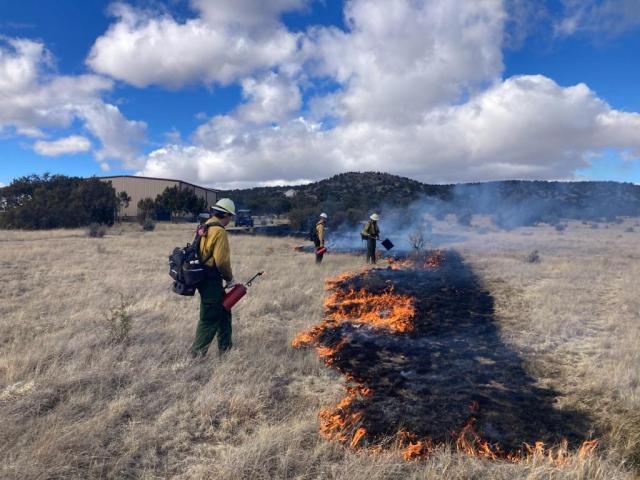BLM plans prescribed burn activities in Chaves County
Organization:
BLM Office:
Media Contact:
ROSWELL, N.M. – Beginning in February, the Bureau of Land Management (BLM) plans to conduct prescribed fire operations in Chaves County. Specifically, the operations are planned to take place in the Lesser Prairie-Chicken Habitat Preservation Area of Critical Environmental Concern near U.S. Route 380 east of Roswell. Many refer to the area as the Sand Ranch ACEC. The operations, which will continue through February and end by March 1, are weather dependent and will take several days to complete.
During the potential burn period, fire management crews monitor the daily weather to decide which date the burn will take place. During a prescribed burn, between 15 and 20 BLM firefighters and support personnel typically remain on scene and monitor the burn until it is safe to leave.
Smoke from the burn may be visible from Roswell, Tatum, Elida, and nearby communities. Although smoke should not impact highways, personnel will post signs along roadways to inform motorists about the potential for smoke. The agency reminds motorists to use caution by reducing speed and watching for fire personnel and equipment.
Because prescribed fires are lower intensity than most wildfires, these operations will decrease the risk of damage from wildfires and loss to adjacent property. Other goals are to improve watershed and habitat conditions, increase the health, vigor, and competitive ability of the native plant community, and reduce the threat of non-native and native invasive plant species.
“We are doing our part to better serve our neighbors and communities by improving rangeland health and wildlife habitat conditions,” said BLM Fire Management Specialist Dominic Bell.
In addition, BLM Wildlife Biologist Danica Cooke said, “Prescribed fire can provide many benefits to the Lesser Prairie-Chicken, including increasing the abundance of invertebrates for chicks to eat and increasing the quality and quantity of habitat types that the birds need throughout their life cycle. There is also evidence that prescribed fire can create vegetation structure advantageous for lekking (mating), and I have observed that the birds will choose to lek in a newly burned area compared to the adjacent, unburned habitat.”
Prior to and during all prescribed fires, fire managers coordinate with the New Mexico Environment Department and follow air quality regulations. In addition, BLM firefighters have engaged in community outreach and coordination with adjacent landowners, range allotment permittees, and county fire personnel. Those who may have health conditions that make them vulnerable to smoke exposure can get information about smoke and protecting their health at https://nmfireinfo.com/smoke-management/. NMED’s air quality monitoring site at https://aqi.air.env.nm.gov and www.airnow.gov are resources for viewing sources of smoke and other factors affecting air quality.
The BLM encourages public land users to continue to be careful with fire. To report a wildfire on public land, call Alamogordo Interagency Dispatch at 877-695-1663. For more information on this prescribed burn and the BLM fire and hazardous fuels reduction program, contact Bell at 575-627-0327. Follow the implementation of this project on NMFireInfo.com or facebook.com/nmfireinfo.
The BLM manages about 245 million acres of public land located primarily in 12 western states, including Alaska, on behalf of the American people. The BLM also administers 700 million acres of sub-surface mineral estate throughout the nation. Our mission is to sustain the health, diversity, and productivity of America’s public lands for the use and enjoyment of present and future generations.

